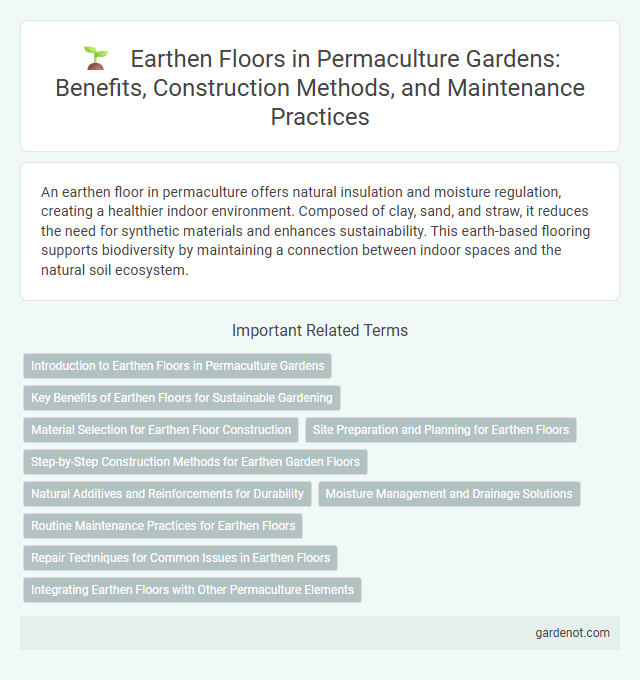An earthen floor in permaculture offers natural insulation and moisture regulation, creating a healthier indoor environment. Composed of clay, sand, and straw, it reduces the need for synthetic materials and enhances sustainability. This earth-based flooring supports biodiversity by maintaining a connection between indoor spaces and the natural soil ecosystem.
Introduction to Earthen Floors in Permaculture Gardens
Earthen floors in permaculture gardens provide a sustainable, natural alternative to conventional flooring by using locally sourced clay, sand, and straw for durability and thermal mass. These floors enhance indoor air quality by regulating humidity and reducing toxins, creating healthier living environments. Implementation of earthen floors aligns with permaculture principles by promoting renewable resources, minimizing waste, and supporting ecological balance.
Key Benefits of Earthen Floors for Sustainable Gardening
Earthen floors enhance sustainable gardening by improving indoor air quality through natural moisture regulation and toxin absorption. Their thermal mass helps maintain stable temperatures, reducing energy consumption for heating and cooling in garden structures. Using locally sourced natural materials minimizes environmental impact and promotes eco-friendly building practices in permaculture design.
Material Selection for Earthen Floor Construction
Selecting materials for earthen floor construction involves prioritizing locally sourced natural components like clay, sand, and straw to enhance sustainability and thermal efficiency. Optimal ratios of these materials ensure structural integrity, moisture retention, and breathability, reducing the need for synthetic additives. Incorporating recycled elements such as broken tiles or aggregate can further improve durability and environmental impact in permaculture settings.
Site Preparation and Planning for Earthen Floors
Site preparation for earthen floors requires thorough assessment of soil composition, moisture levels, and drainage to ensure a stable and durable base. Planning involves selecting a level, well-drained area and incorporating natural materials such as clay, sand, and straw to enhance structural integrity and thermal regulation. Proper compaction and layering techniques optimize floor longevity and comfort within permaculture designs.
Step-by-Step Construction Methods for Earthen Garden Floors
Begin by clearing the garden area of debris and leveling the soil to create a smooth, stable base for the earthen floor. Compact the leveled soil using a tamper or roller to increase density and prevent future settling. Finally, mix natural materials such as clay, sand, and straw into the compacted soil, spread it evenly, and allow it to dry completely to achieve a durable, breathable earthen floor suitable for permaculture gardens.
Natural Additives and Reinforcements for Durability
Natural additives such as straw, hemp fibers, and animal dung enhance the durability of earthen floors by increasing tensile strength and reducing cracking. Incorporating natural binders like clay, lime, or natural latex improves moisture resistance and longevity. Using these eco-friendly reinforcements aligns with permaculture principles by promoting sustainable, low-impact building materials.
Moisture Management and Drainage Solutions
Earthen floors in permaculture systems excel in moisture management by naturally regulating humidity through their porous structure, which absorbs and releases moisture efficiently. Effective drainage solutions, such as incorporating gravel beneath the floor and ensuring proper slope design, prevent water accumulation and structural damage. Integrating these techniques enhances indoor air quality and prolongs the durability of earthen floor installations.
Routine Maintenance Practices for Earthen Floors
Routine maintenance practices for earthen floors include regular sweeping with a soft broom to remove dust and debris without damaging the surface. Periodic application of natural oils, such as linseed or tung oil, helps to preserve the floor's durability and enhance water resistance. Addressing minor cracks or wear promptly with a mixture of clay, sand, and natural binders ensures the longevity and structural integrity of the earthen flooring.
Repair Techniques for Common Issues in Earthen Floors
Earthen floors often develop cracks and surface wear that can be efficiently repaired using natural clay-based mixtures combined with straw or sand to restore structural integrity and aesthetic appeal. Repair techniques include cleaning damaged areas, moistening the surface for better adhesion, and applying a fresh layer of earthen plaster to fill cracks or holes. Maintaining proper moisture balance and using locally sourced materials enhances durability while preserving the ecological benefits of earthen floors in permaculture settings.
Integrating Earthen Floors with Other Permaculture Elements
Earthen floors naturally enhance thermal mass, regulating indoor temperatures and reducing energy demands in permaculture homes. Combining earthen floors with passive solar design, green roofs, and rainwater harvesting systems creates a holistic, sustainable living environment. Incorporating local, natural materials in earthen floor construction supports soil health and biodiversity, aligning with permaculture principles of closed-loop resource use.
Earthen floor Infographic

 gardenot.com
gardenot.com